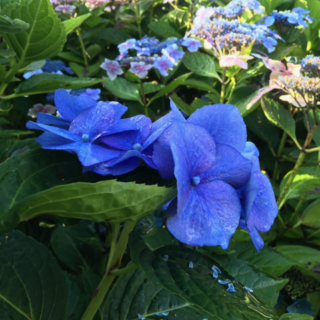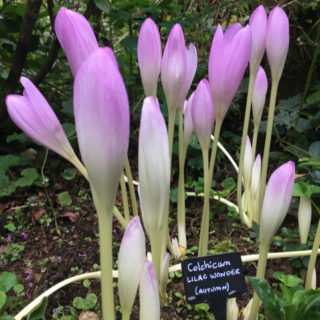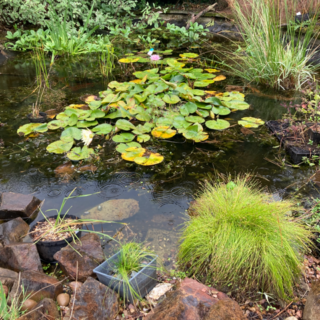“The redbreast whistles from a garden-croft,
And gathering swallows twitter in the skies”
John Keats, “To Autumn”
To me, the sound of a robin’s song is definitely different come September. Whether it is due to the bird changing its behaviour, or due to a slight change in the atmosphere, but there is a distinct autumn sound to its notes. Perhaps even slightly mournful. But to me it summons images of crisp autumn leaves, blazing trees and shrubs, the first frost (I haven’t always lived in Cornwall!), the deep smell of humus in the woods.
This week the swallows were starting to gather on the phone lines strung across the field behind us and the honk of geese in the sky was evident as well.
 Some relief has arrived in the form of rain, which I’m sure we will be cursing once again by October, although Cornwall still has a hosepipe ban. The ban is not as straightforward as it seems though. You can’t use a hosepipe, unless you are piping rainwater out of your own storage device or a borehole. Or you have laid a new lawn within 28 days, or have new planting within 14 days, or if fish are at risk in a low pond. But you can use a watering can to carry out most activities.
Some relief has arrived in the form of rain, which I’m sure we will be cursing once again by October, although Cornwall still has a hosepipe ban. The ban is not as straightforward as it seems though. You can’t use a hosepipe, unless you are piping rainwater out of your own storage device or a borehole. Or you have laid a new lawn within 28 days, or have new planting within 14 days, or if fish are at risk in a low pond. But you can use a watering can to carry out most activities.
Amaryllis belladonna
Trees and shrubs
By the end of September I usually make sure that I have pruned all the evergreen shrubs in the garden. Deciduous ones such as berberis and privet can wait until winter. Hedges can also be cut at this time, and give topiary one last cut if necessary.
Now is a good time to plant a containerized tree, shrub or rose, providing you water it in well or wait until the soil is damp through again. It is still warm this month which gives the plant a chance to put out new roots before winter.
Dig a hole larger than the roots and mix in preferably some garden compost for extra organic matter, or bagged stuff if you don’t have any. I usually throw in some pelleted chicken manure and fill the hole with water, then add the plant at the same depth as it was in the pot (or higher if the tree has been repotted too deeply), firm gently, add a tree stake at a 45 degree angle pointing in to the prevailing wind if necessary and fix with a rubber tree tie, water, then mulch around the new plant – making sure the mulch doesn’t touch the stem. Remember to water them if there’s anything less than average amounts of autumn rain.
Herbaceous borders
 Continue deadheading to persuade plants to keep going. This year though, many may have gone over just too early because of a lack of water. Some of mine have died off completely as if it was November. The plants aren’t dead, it is their survival mechanism to save what they’ve got into their storage organs and come back again when times are better. Just tidy them up for now. You can always add a bit of autumn bedding for colour. This is the ‘false autumn’ many horticulturalists are talking about.
Continue deadheading to persuade plants to keep going. This year though, many may have gone over just too early because of a lack of water. Some of mine have died off completely as if it was November. The plants aren’t dead, it is their survival mechanism to save what they’ve got into their storage organs and come back again when times are better. Just tidy them up for now. You can always add a bit of autumn bedding for colour. This is the ‘false autumn’ many horticulturalists are talking about.
I walked through the woods this morning with the dogs and the ground is covered with sycamore leaves. Eventually when a tree is felled, these are the years where the rings in the trunk are tightly packed because the tree has put on very little growth due to lack of water. I noticed a willow which looked like a stag horn oak – it had apparently abandoned its top most branches in favour of keeping the rest of the tree alive.
 Herbaceous perennials can lifted and divided now, and new plants added to the border. If you are fond of self-seeders then these can be saved and moved now, before they disappear for winter and pop back up next year when you realise they are in the wrong place. I usually move a few foxgloves, forget-me-nots, aquilegias and linaria around.
Herbaceous perennials can lifted and divided now, and new plants added to the border. If you are fond of self-seeders then these can be saved and moved now, before they disappear for winter and pop back up next year when you realise they are in the wrong place. I usually move a few foxgloves, forget-me-nots, aquilegias and linaria around.
Hardy annuals can be sown for early flowerings next year, such as love-in-a-mist, calendula, cornflower, poppies, clary sage and Ammi visnaga. If you sow again in spring you will get a succession of plants all summer.
Start planting daffodils, crocuses, early irises and other spring bulbs as you receive them. Tulips should wait until November when it has got a fair bit colder. The usual guidance is after the first frosts but for us that could be in January! I just make sure they are in the ground by Christmas, earlier if it looks as though the bulbs may not store well enough.

The productive garden
The bountiful harvest continues; your neighbours, friends, family and even people you chance across may have had all manner of vegetable edibles pressed upon them by now! There has been a bumper tomato crop this year, we tried a couple of plants of our own which have done better than ever before, plus we help look after the neighbour’s crop who have a super greenhouse full of them. September is the month to share new tomato recipes! I just love plucking sun-warmed cherry tomatoes straight off the plant as a snack.
Our autumn raspberries are now getting in to their stride. Sadly this year the blueberries have come to nothing, but there are plenty of blackberries in the hedge and our cooking apples won’t be far behind, there is a bumper crop this year too.
This year I bought grafted chill plants for the first time. I am not sure the plants are better than seed grown, perhaps they were earlier though. I have a seed grown Apache plant that must be in its third year by now and has produced hundreds of rather hot chilies this year, far too many for us along with the grafted F1 Medina and Hungarian Hot Wax I thought I’d try.
This month, plant up strawberry runners, new fruit bushes and sow winter salad leaves such as spinach and lettuce. Also dig up layered blackberries, raspberry root runners, divide rhubarb and take hardwood cuttings of gooseberries and currents if you need them.
If you find that, after harvest, you have bare areas of ground in your plot you might want to consider sowing a green manure such as mustard and red or crimson clover. Not only will this feed the soil but it will keep it covered and protected from the winter weather, preventing compaction and erosion from heavy rain. Simply dig it in next spring a couple of weeks before you want to use the plot again.
Looking after the wildlife this month, it is time to start feeding the birds again. They should have finished moulting and have come back out from their shelters to look for plenty of food to fatten up for winter.
At the end of August we cleared out our ponds, admittedly this was the first time in four years and it desperately needed doing. Now is a good time before the temperature drops and pond creatures start thinking about hibernation because some bury themselves in the pond sediment. Divide pond plants, remove excess sediment and dead plant material, then you might want to net the pond to prevent autumn leaves clogging it back up again.

Caroline Kenzie

